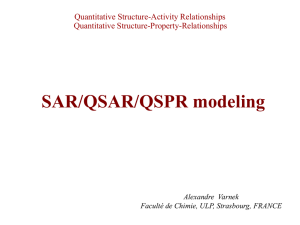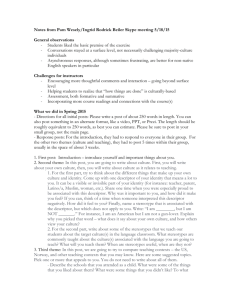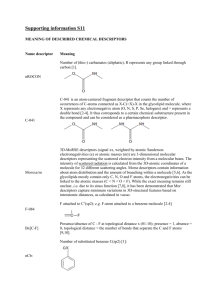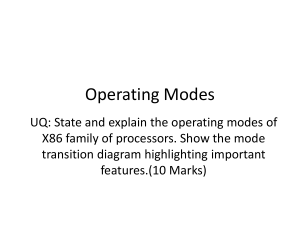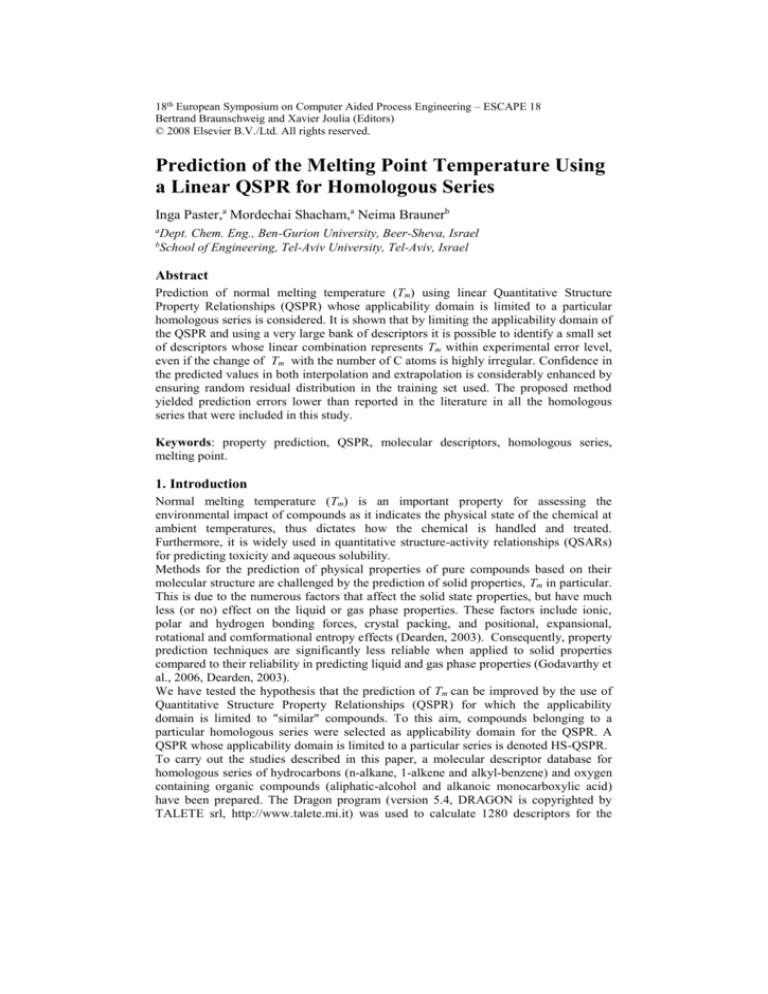
18th European Symposium on Computer Aided Process Engineering – ESCAPE 18
Bertrand Braunschweig and Xavier Joulia (Editors)
© 2008 Elsevier B.V./Ltd. All rights reserved.
Prediction of the Melting Point Temperature Using
a Linear QSPR for Homologous Series
Inga Paster,a Mordechai Shacham,a Neima Braunerb
a
b
Dept. Chem. Eng., Ben-Gurion University, Beer-Sheva, Israel
School of Engineering, Tel-Aviv University, Tel-Aviv, Israel
Abstract
Prediction of normal melting temperature (Tm) using linear Quantitative Structure
Property Relationships (QSPR) whose applicability domain is limited to a particular
homologous series is considered. It is shown that by limiting the applicability domain of
the QSPR and using a very large bank of descriptors it is possible to identify a small set
of descriptors whose linear combination represents Tm within experimental error level,
even if the change of Tm with the number of C atoms is highly irregular. Confidence in
the predicted values in both interpolation and extrapolation is considerably enhanced by
ensuring random residual distribution in the training set used. The proposed method
yielded prediction errors lower than reported in the literature in all the homologous
series that were included in this study.
Keywords: property prediction, QSPR, molecular descriptors, homologous series,
melting point.
1. Introduction
Normal melting temperature (Tm) is an important property for assessing the
environmental impact of compounds as it indicates the physical state of the chemical at
ambient temperatures, thus dictates how the chemical is handled and treated.
Furthermore, it is widely used in quantitative structure-activity relationships (QSARs)
for predicting toxicity and aqueous solubility.
Methods for the prediction of physical properties of pure compounds based on their
molecular structure are challenged by the prediction of solid properties, Tm in particular.
This is due to the numerous factors that affect the solid state properties, but have much
less (or no) effect on the liquid or gas phase properties. These factors include ionic,
polar and hydrogen bonding forces, crystal packing, and positional, expansional,
rotational and comformational entropy effects (Dearden, 2003). Consequently, property
prediction techniques are significantly less reliable when applied to solid properties
compared to their reliability in predicting liquid and gas phase properties (Godavarthy et
al., 2006, Dearden, 2003).
We have tested the hypothesis that the prediction of Tm can be improved by the use of
Quantitative Structure Property Relationships (QSPR) for which the applicability
domain is limited to "similar" compounds. To this aim, compounds belonging to a
particular homologous series were selected as applicability domain for the QSPR. A
QSPR whose applicability domain is limited to a particular series is denoted HS-QSPR.
To carry out the studies described in this paper, a molecular descriptor database for
homologous series of hydrocarbons (n-alkane, 1-alkene and alkyl-benzene) and oxygen
containing organic compounds (aliphatic-alcohol and alkanoic monocarboxylic acid)
have been prepared. The Dragon program (version 5.4, DRAGON is copyrighted by
TALETE srl, http://www.talete.mi.it) was used to calculate 1280 descriptors for the
2
I. Paster et al.
compounds in the database. Melting point data were taken from the DIPPR (Rowley et
al., 2006) database. A modified version of the stepwise regression program (SROV) of
Shacham and Brauner (2003) was used for the identification of the most appropriate
QSPRs.
2. The HS-QSPR method
For development of the QSPR the members of the homologous series are divided into a
training set which includes only compounds for which Tm data are available and an
evaluation set in which Tm data are available only for part of the compounds. Shacham
et al., (2007) have shown that using ten compounds is sufficient as a training set. For
predicting Tm for the members of the homologous series, a linear structure-property
relation is assumed of the form:
y 0 1ζ1 2ζ 2 mζ m ε
(1)
where y is a p-dimensional vector of the respective property (known, measured) values
(p is the number of compounds included in the training set), ζ1, ζ2 … ζm are m pdimensional vectors of predictive molecular descriptors, are the corresponding model
parameters to be estimated, and ε is a p-dimensional vector of stochastic terms (due to
measurement errors).
The descriptors are selected to the model in a stepwise manner according to the value of
the partial correlation coefficient, |yj| between the vector of the property values y, and
that of a potential predictive descriptor ζj. The partial correlation coefficient is defined
as
yj y ζ Tj , where y
and
ζ j are row vectors, centered (by subtracting the mean)
and normalized to a unit length|yj|. Values close to one indicate high correlation
between molecular descriptor and the property value. The training set average percent
error can be used for estimating the expected prediction error. It is defined as:
a
1 p
100 yi 0 1 1,i 2 2,i m m,i / yi
p i 1
(2)
Addition of new descriptors to the model may continue as long as the calculated average
error is greater than the pre-specified error tolerance (εa > εg ) and the signal-to-nose
indicators of the SROV program are not violated. The stepwise regression program
SROV (Shacham and Brauner, 2003) is used, which selects in each step one molecular
descriptor that reduces the prediction error most strongly.
Tm values for the members of the evaluation set are estimated by:
~
yt 0 1 t1 2 t 2 m tm
where
(3)
~
yt is the estimated (unknown) property value of the respective compound and
ζt1, ζt2 … ζtm are its corresponding molecular descriptors values.
3. Predicting Tm for the alkanoic, monocarboxylic acid series.
The first 19 members of the alkanoic, monocarboxylic series (shown in Table 1) were
included in this study. Experimental Tm values (shown in Table 1 and Figure 1) are
available for all of them in the DIPPR database. The estimated experimental error
(reliability) of the data is < 1%.
Predicting Melting Point Temperature Using a Linear QSPR for Homologous Series
Table 1. Reference data and results for predicting Tm of alkanoic, monocarboxylic acids
Tm (K)1
HS - QSPR
Experimental Prediction % error
no. of C
atoms
Acid
2
Methanoic
Ethanoic
Propanoic
Butanoic
Pentanoic
Hexanoic
Heptanoic
Octanoic
Nonanoic
Decanoic
undecanoic
dodecanoic
tridecanoic
tetradecanoic
pentadecanoic
hexadecanoic
heptadecanoic
octadecanoic
eicosanoic
1
2
3
4
5
6
7
8
9
10
11
12
13
14
15
16
17
18
19
281.55
289.81
252.45
267.95
239.15
269.25
265.83
289.65
285.55
304.75
301.63
316.98
315.01
327.37
325.68
335.66
334.25
342.75
348.23
281.67
289.94
251.08
267.73
238.59
269.35
269.84
288.66
284.91
304.18
302.43
316.20
316.13
326.82
325.02
333.30
333.49
341.80
348.69
1
Data from the DIPPR database
2
Members of the training set are shown in bold letters
0.04
0.04
0.54
0.08
0.24
0.04
1.51
0.34
0.22
0.19
0.26
0.25
0.35
0.17
0.20
0.70
0.23
0.28
0.13
PJI2
Descriptor
IVDE
EEig06x
1
1
0.5
1
0.667
1
0.75
1
0.8
1
0.833
1
0.857
1
0.875
1
0.889
1
1
0.918
0.811
1.371
1.459
1.449
1.406
1.352
1.295
1.241
1.189
1.14
1.095
1.053
1.014
0.978
0.944
0.913
0.884
0.832
PJI2
IVDE
6
8
Mor16v
0
0
0
0
-0.754
-0.255
0.217
0.425
0.571
0.853
1.138
1.382
1.588
1.76
1.904
2.027
2.13
2.219
2.362
EEig06x
0.016
-0.015
-0.073
-0.056
-0.066
-0.095
-0.091
-0.098
-0.097
-0.115
-0.096
-0.09
-0.092
-0.084
-0.078
-0.067
-0.081
-0.083
-0.097
Mor16v
3
360
2.5
340
Descriptor Value
Normal Melting Temp. (K)
2
320
300
280
1.5
1
0.5
0
260
0
2
4
10
12
14
16
18
20
-0.5
240
-1
220
No. of C Atoms
0
2
4
6
8
10
12
14
16
18
20
No. of C Atoms
Figure 1. Experimental Tm values of
alkanoic, monocarboxylic acids
Figure 2. Descriptor values vs. the number
of C atoms for the alkanoic acids.
Observe that the behavior of Tm versus nC is very irregular. For low carbon numbers the
general trend is decrease of Tm with the increasing nC. Starting at nC = 6 the trend is
reversed. However, in addition to the general trend there are also oscillatory changes
between neighboring compounds. It is rather difficult to model such an irregular
behavior.
To identify the molecular descriptors that should be included in the regression model all
18 out of the 19 compounds shown in Table 1 were included in the training set. The
SROV program has identified the descriptor EEig06x as having the highest correlation
with Tm (|yj| = 0.967). EEig06x is a two dimensional (2D) descriptor belonging to the
category of "edge adjacency indices", described by Dragon as "eigenvalue 06 from edge
adjacency matrix weighted by edge degrees". In Figure 2 several descriptors are plotted
versus nC. Observe that EEig06x represents well the general trend of the Tm curve, but
not the oscillations. It is important to point out that there are several additional
descriptors which are highly correlated with Tm however their (|yj| values are slightly
lower than that of EEig06x. One of these descriptors, for example, is SIC3 which is also
a 2D descriptor belonging to the "information indices" category ("structural information
3
4
I. Paster et al.
content (neighborhood symmetry of 3-order)" for which |yj| = 0.965. Thus, from
among the 1280 descriptors several combinations can possibly be found, which yield
predictions of Tm of a similar precision.
The next descriptor to enter the QSPR is PJI2 ("2D Petitjean shape index" from the
"information indices" category) with |yj| = 0.965. Observing the behavior of this
descriptor in Figure 2 reveals that this descriptor represents only the oscillations. The
combination of these two descriptors provides very precise representation of Tm for
most compounds involved (prediction error < 1%) except for ethanoic-acid and butanoic
-acid for which the prediction error is ~ 4%. Two additional descriptors have to be
added to the QSPR in order to reduce the error in the representation of Tm for these two
compounds.
To validate the extrapolation capabilities of the QSPR for predicting Tm of the alcanoic
acid series, the parameters of the QSPR are derived using a training set of 10
compounds which are identified in Table 1. The HS-QSPR obtained is Tm = 277.32 +
44.84 PJI2 - 41.98 IVDE + 21.02 EEig06x -121.81 Mor16v. The prediction errors when using
this QSPR are below experimental error level (< 1%, see Table 1) in all except one case
(for heptanoic acid the error is 1.51 %). The mean absolute error is 0.9 K. Dearden
(2003) provides a summary of the prediction errors reported in connection to using
various QSPRs for predicting melting points of various groups of compounds. Average
errors are reported in the range of 8.1 K through 47.8 K. Thus, the precision of the HSQSPR is considerably higher than that of the other QSPRs reviewed by Dearden (2003).
4. Predicting Tm for the 1-alkene series.
Twenty seven members of the 1-alkene containing between 4 to 30 carbon atoms were
included in this study (Table 2). For the first 17 compound Tm values (either measured
or predicted) are available in the DIPPR database with reliability ranging between 0.2 %
and 1.0. All the compounds for which the data are marked as experimental(except 1heptene, 9 compounds) were included in the training set. The first descriptor to enter the
QSPR was TIC5 (a 2D descriptor belonging to the "information indices" category: "total
information content index, neighborhood symmetry of 5-order" ) with |yj| = 0.99985.
The meaning of such a high value of the correlation coefficient can be understood in
reference to Figure 3. In this Figure the reported Tm values as well as the descriptor
values are plotted versus nC, for the 1-alkene series. Observe that, for this series, there is
a smooth, monotonic increase of Tm with increasing nC. Furthermore, the descriptor
TIC5 is almost completely collinear with Tm. This can be verified by plotting Tm versus
TIC5 (Figure 4) which yields an almost perfect straight line. The one descriptor QSPR:
Tm = 75.4013+1.0267TIC5 yields predictions with error smaller than 1% for most of the
compounds, however there are excessive error values for 1-pentene (4.7%) and 1nonene (2.0%). An even more serious deficiency of this model can be detected by
inspecting its residual plot (not shown). The residuals of the one descriptor model
exhibit a definite curvature, with a decreasing trend at high carbon numbers.
Consequently, there is a consistent increase in the error starting from Tm = 184.4 K. If
this model is to be used for extrapolation (as required, according the data available in
Table 2) we can expect the prediction error to grow even further. The three descriptor
HS-QSPR reads: Tm=106.47+0.7336TIC5+42.83BELp5-57.96L2p.
Its prediction errors are within experimental error level (Table 2). Furthermore, it
provides residual plot (not shown) with randomly distributed residuals which indicates
that the model is safer for extrapolation than the one descriptor model.
Predicting Melting Point Temperature Using a Linear QSPR for Homologous Series
Table 2. Reference data and results for predicting Tm of 1-alkenes
Name
1-butene
1-pentene
1-hexene
1-heptene
1-octene
1-nonene
1-decene
1-undecene
1-dodecene
1-tridecene
1-tetradecene
1-pentadecene
1-hexadecene
1-heptadecene
1-oktadecene
1-nonadecene
1-eicosene
1-heneicosene
1-docosene
1-tricosene
1-tetracosene
1-pentacosene
1-hexacosene
1-heptacosene
1-octacosene
no. of C
atoms
4
5
6
7
8
9
10
11
12
13
14
15
16
17
18
19
20
21
22
23
24
25
26
27
28
1-nonacosene
1-triacontene
1
T m (K)1 HS - QSPR
Reported Prediction
87.8
87.78
108.016
109.31
133.39
133.78
154.12
154.07
171.45
172.34
191.91
190.97
206.9
207.36
223.99
224.94
237.95
237.96
250.08
250.75
260.3
260.15
269.42
269.24
277.51
276.65
284.4
284.04
290.76
290.35
296.55
296.65
301.76
302.15
307.74
312.65
317.74
322.29
326.92
331.13
335.45
339.38
29
30
-
343.46
347.23
% error
0.03
1.19
0.29
0.03
0.52
0.49
0.22
0.42
0.01
0.27
0.06
0.07
0.31
0.13
0.14
0.03
0.13
-
TIC5
11.651
36.697
57.651
75.268
93.284
109.627
126.452
143.71
157.362
169.866
179.722
188.404
196.304
203.626
210.499
217.01
223.22
229.177
234.917
240.468
245.854
251.094
256.204
261.196
266.083
-
270.873
275.576
Descriptor
BELp5
0
0.094
0.343
0.511
0.675
0.822
0.949
1.057
1.149
1.228
1.295
1.353
1.403
1.446
1.485
1.518
1.548
1.574
1.597
1.618
1.636
1.653
1.668
1.682
1.694
1.706
1.716
L2p
0.47
0.485
0.512
0.509
0.543
0.537
0.561
0.556
0.572
0.568
0.58
0.576
0.585
0.582
0.589
0.587
0.593
0.591
0.596
0.594
0.597
0.596
0.599
0.598
0.601
0.6
0.602
Data from the DIPPR database
5. Conclusions
Prediction of the normal melting temperatures of alkanoic acids has demonstrated that
by limiting the range of applicability of the QSPR to a particular homologous series and
using a very large bank of descriptors it is possible to identify a small set of descriptors
whose linear combination represents Tm within experimental error level, even if the
change of Tm with the number of C atoms is highly irregular.
In cases when the change of Tm with the number of C atoms is smooth and monotonic
an HS-QSPR containing only one descriptor can provide prediction of acceptable
precision if interpolation is involved (as shown in the example of 1-alkenes). However,
if the available data dictate prediction by extrapolation addition of more descriptors,
until reaching random residual distribution, can provide some confidence in the
predicted values.
A more extensive discussion on the advantages of the proposed method over other
property prediction methods (such as the ones using PCA or neural networks) can be
found in Kahrs et al (2007). Results of applying the proposed method for additional
homologous series and comparison of the accuracy of the predicted Tm with other
methods are presented in Brauner et al. (2008).
5
6
I. Paster et al.
References
N. Brauner, R. P. Stateva, G. St. Cholakov, M. Shacham, 2006, A structurally “targeted” QSPR
method for property prediction, Ind. Eng. Chem. Res., 45, 8430-8437.
N. Brauner, G. St. Cholakov, O. Kahrs, R. P. Stateva, and M. Shacham, 2008, Linear QSPRs for
Predicting Pure Compound Properties in Homologous Series, (AIChE J, Accepted ).
J. C. Dearden, 2003, Quantitative structure–property relationships for prediction of boiling point,
vapor pressure, and melting point. Environ. Toxicol. Chem., 22, 1696–1709.
S. S. Godavarthy, R. L. Robinson, K.A.M Gasen, 2006, An improved structure-property model
for predicting melting point temperatures, Ind. Eng. Chem. Res., 45, 5117–5126.
O. Kahrs, N. Brauner, G. St. Cholakov, R. P. Stateva, W. Marquardt and M. Shacham, 2007,
Analysis and Refinement of the Targeted QSPR Method, Computers chem. Engng.,
doi:10.1016/j.compchemeng.2007.06.006.
R. L. Rowley, W. V. Wilding,J. L. Oscarson,Y. Yang,N. A. Zundel,2006, DIPPR Data
Compilation of Pure Chemical Properties Design Institute for Physical Properties.
http//dippr.byu.edu, Brigham Young University Provo Utah.
M. Shacham, N. Brauner, 2003, The SROV program for data analysis and regression model
identification. Comput. Chem. Eng., 27, 701–714.
M. Shacham, O. Kahrs, G.St. Cholakov, R. P. Stateva, W. Marquardt, N. Brauner,2007, The Role
of the Dominant Descriptor in Targeted Quantitative Structure Property Relationships", Chem.
Eng. Sci. 62 (22), 6222-6233.
Normal Melting Temp (K)/Descriptor Value
350
300
250
200
150
Tm
TIC5
100
50
0
4
6
8
10
12
14
16
18
20
No. of C atoms
Figure 3. Reported Tm and descriptor TIC5 values of 1-alkenes
350
Normal Melting Temp. (K)
300
y = 1.0267x + 75.401
R2 = 0.9992
250
200
150
100
50
0
0
50
100
150
200
250
Descriptor TIC5
Figure 4. Reported Tm values versus descriptor TIC5 of 1-alkenes



